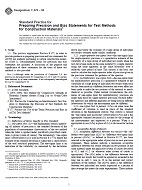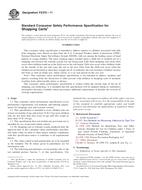1.1 This test method covers the quantitative online determination by direct comparison of the difference in knock rating or delta octane number of a stream sample of spark-ignition engine fuel from that of a comparison reference fuel.
1.2 This test method covers the methodology for obtaining an octane number using the measured delta octane number and the octane number of the comparison reference fuel.
1.3 The comparison reference fuel is required to be of essentially the same composition as the stream sample to be analyzed and can be a secondary fuel termed standard fuel or a tertiary fuel termed prototype fuel.
1.4 The test method utilizes a knock testing unit/automated analyzer system that incorporates computer control of a standardized single-cylinder, four-stroke cycle, variable compression ratio, carbureted, CFR engine with appropriate auxiliary equipment using either Test Method D 2699 Research method or Test Method D 2700 Motor method operating conditions.
1.4.1 Knock measurements are based on operation of both fuels at the specific fuel-air ratio that produces maximum knock intensity for that fuel.
1.4.2 Measured differences in knock intensity are scaled to provide a positive or negative delta octane number of the stream sample from the comparison reference fuel when the fuels are compared at the same compression ratio.
1.4.3 Measured differences in compression ratio are scaled to provide a positive or negative delta octane number of the stream sample from the comparison reference fuel when the fuels are compared at the same knock intensity.
1.5 This test method is limited to testing 78 to 102 octane number spark-ignition engine fuels using either research or motor method conditions.
1.6 The octane number difference between the stream sample and the applicable comparison reference fuel is self-limiting by specifications imposed upon the standard and prototype fuels.
1.7 Specifications for selection, preparation, storage, and dispensing of standard and prototype fuels are provided. Detailed procedures for determination of an appropriate assigned octane number for both standard and prototype fuels are also incorporated.
1.8 The values of operating conditions are stated in SI units and are considered standard. The values in parentheses are historical inch-pound units. The standardized CFR engine measurements continue to be expressed in inch-pound units only because of the extensive and expensive tooling that has been created for this equipment.
1.9 This standard does not purport to address all of the safety concerns, if any, associated with its use. It is the responsibility of the user of this standard to establish appropriate safety and health practices and determine the applicability of regulatory limitations prior to use. For more specific warning statements, see Section 8 and Annex A1.
Product Details
- Published:
- 07/01/2008
- Number of Pages:
- 16
- File Size:
- 1 file , 190 KB
- Redline File Size:
- 2 files , 350 KB


